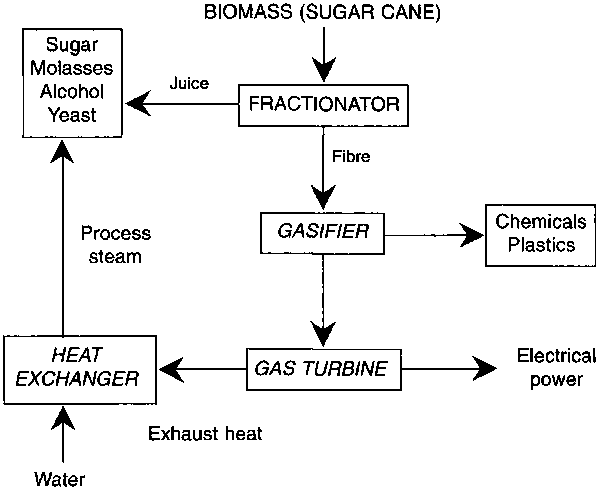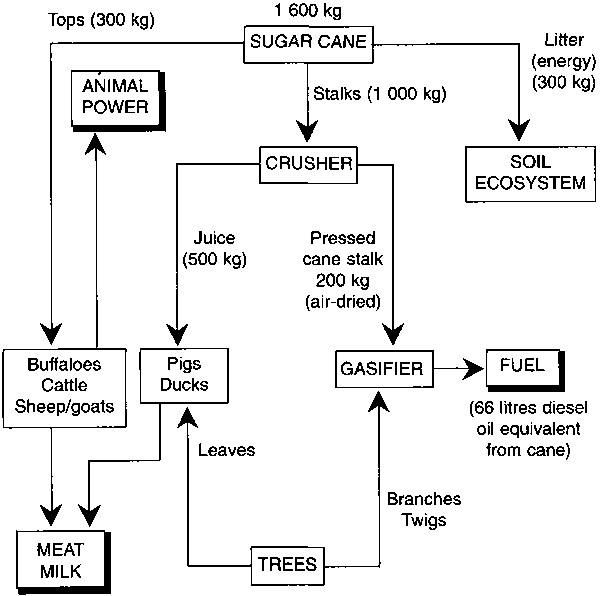The future role of livestock production in developing tropical countries
Research and development
Future needs
Bibliography
T.R. PrestonAt the time of writing the author was working at the Centro de Investigación en Sistemas Sostenibles de Producción Agropecuaria, Cali, Colombia. His present address is: University of Agriculture and Forestry, Thu Duc, Ho Chi Minh City, Viet Nam.
Two events will influence profoundly the role of livestock in farming systems in developing countries in the next century. The first is the projected doubling of the world population, which will be concentrated in the developing world. The second is the increasing aspirations of people in developing countries to attain those amenities taken for granted in developed countries. The economic development required to produce these amenities will result in a massive increase in demand for energy in all its forms (Figure 1).
The world currently derives some 60 percent of its energy from fossil fuels. The supplies of these are limited and, at the present (1993) rate of consumption, will last only 60 years, while at the rate of consumption projected for the year 2005, the reserves of fossil fuel are likely to last less than 30 years (The Economist, 1994). Inevitably, prices will soon begin to rise faster than the average rate of inflation. An equally worrying consequence of the projected increase in fossil-fuel consumption is the emission of the greenhouse gas carbon dioxide, whose rate of accumulation in the atmosphere is expected to double. Finally, economic development brings in its wake the loss of jobs as human labour is replaced by mechanical and electrical devices.
The implications for agricultural production will be many, especially in the less-developed tropical countries, including:
· Increasing importance will be given to the production and utilization of renewable forms of energy, especially biomass.· Farming systems will be geared to practices that increase the sinks for the greenhouse gases carbon dioxide and methane.
· There will be a competing demand for cereal grains -currently the basis of livestock production in the more-developed countries - to feed the increasing human population, which will result in higher prices.
· Natural renewable resources will have to be used more efficiently, farming systems will need to create more employment opportunities, especially for women and children, and the role of livestock in the system will be increasingly catalytic rather than an end in itself.
· Mechanization will be increasingly based on animal rather than machine power.
This scenario will create opportunities for crops that give rise to products that can replace cereal grains in the diet of monogastric livestock; that are potential sources of renewable energy in the form of biomass; that are environmentally friendly; and that can be cultivated and processed by small-scale farmers.
Sugar cane is highly productive and efficient in converting solar energy into biomass. It is also easily fractionated into readily digestible sugars and residual fibre. Traditionally it has been cultivated and processed primarily for the production of sucrose. Since the mid-1960s, however, sugar cane has been a focal point for activities directed at developing alternatives to cereal grains as a means of intensifying tropical livestock production. Research was first focused on the use of the whole sugar-cane plant as a basis for intensive cattle fattening, but the major step forward occurred when it was demonstrated that the juice, extracted from the stalk by means of traditional trapiches (two- and three-roll sugar-cane crushers), could be fed to pigs as a complete replacement for cereals. The attraction of the system was enhanced when it was found that the overall dietary protein level could be reduced by some 40 percent with no loss in performance.
These important developments were summarized at an FAO Expert Consultation on the Uses of Sugarcane as Animal Feed held in the Dominican Republic in 1986 (Sansoucy, Aarts and Preston, 1988).
Further activities with sugar cane were carried out in Colombia where the juice-feeding system for pigs was adopted as an alternative and complementary activity for small-scale farmers who were engaged in artisan brown sugar (panela) production (Sarria, Solano and Preston, 1990). The fact that the cane juice did not contain any fibre led to research with tree foliages and water plants as potential sources of protein. The water fern Azolla (Azolla sp.) (Becerra et al., 1990) and leaves from the tree Trichanthera gigantea were found to be readily consumed by pigs at levels of 30 percent of replacement of the conventional protein source, which was usually supplied as soybean meal (Sarria, Villavicencio and Orejuela, 1991; Sarria, 1994).
When juice is squeezed from the sugar-cane stalk in a single pass through a three-roll crusher, the maximum amount that can be extracted is only 50 percent of the weight of the stalk. This is equivalent to an extraction rate of some 75 percent of the total juice in the stalk. The remaining juice stays in the fibrous residue, which contains on average 25 percent juice solids and 75 percent fibre (dry-matter basis). This sugar-rich fibre has potential as a feed for ruminants, especially when offered at a level much beyond the actual amount that is consumed. Recent research in Colombia has shown that offering the fibrous waste at rates exceeding the amount consumed by 100 percent leads to a 50 percent improvement in intake by sheep (Vargas et al., 1994). The integrated use of sugar cane to feed both pigs and cattle has been evaluated on the El Hatico farm in Colombia (Figure 2). A yield of 180 tonnes of harvestable biomass per hectare per year translates into 7 750 kg of liveweight gain (4 690 kg for pigs; 3 060 kg for cattle) and a net income of over US$2 000.
Sugar-cane juice has been fed to ducks with resulting rates of growth and conversion only slightly inferior to those obtained with cereal grain (Bui Xuan Men and Vuong Van Su, 1992). The potential of the sugar-cane stalk as a replacement for cereal-based concentrates in diets for rabbits is also being investigated. The only processing that would be required is cutting it into lengths of 20 to 30 cm and splitting it endwise. Preliminary results for growth and reproduction performance were the same as with the concentrate control (Nguyen Quang Suc et al., 1994).
In 1989, the technology for using sugar cane as a source of feed and fuel for small-scale farmers was transferred through a project supported by FAO (TCP/PHI/8954) to the Philippines and by projects supported by FAO (TCP/VIE/8954) and the Swedish Agricultural Research Centre (SAREC) to Viet Nam. The social conditions (small-scale integrated crop-livestock systems), ecological need (high pressure on natural resources leads to a high opportunity value of fuel) and cultural traditions (most householders keep pigs for manure and income) combined to provide a major stimulus for using sugar-cane juice to feed pigs. The most relevant findings were that adoption was greatest in the more remote and poorer mountainous regions of the country, and that all the crop was used - the juice for pigs, the tops for buffaloes and cattle, the (dried) residual stalk as a replacement for fuelwood for cooking and the dead leaves as mulch or for thatching (Nguyen Thi Oanh, 1994).
The potential of sugar cane as a source of renewable energy received worldwide attention as a result of the Brazilian Alcohol Programme. Alexander (1985) promoted research in Puerto Rico to project the potential of the whole plant as a source of biomass to replace oil in thermal electricity factories for steam generation. A more promising approach, however, is the integration of the fuel element with livestock production (Figure 3). After feeding both pigs and cattle, the equivalent of 66 litres of diesel oil in the form of synthesis gas can be produced theoretically from 1 tonne of sugar-cane stalk. Research on the use of the residual pressed stalk in small-scale gasifiers is currently in progress (A. Lindgren, T.R. Preston and A. Zapata, unpublished data).
1 - World demand for primary energy - Demande mondiale d'énergie primaire - Demanda mundial de energía primaria

2 - Integrated use of sugar cane for pigs and cattle - Utilisation intégrée de la canne à sucre pour les porcins et les bovins - Utilización integrada de la caña de azúcar para cerdos y vacunos

3 - Flow diagram for cogeneration of electricity and sugar-derived products from sugar cane - Diagramme des opérations pour la production combinée d'électricité et de produits dérivés du sucre à partir de la canne à sucre - Diagrama de flujo de la obtención de electricidad y productos derivados del azúcar a partir de la caña

4 - Flow diagram for Integrated use of sugar cane at small-scale household and village farm levels - Diagramme des opérations pour l'utilisation Intégrée de la canne à sucre au niveau de la petite exploitation familiale ou villageoise - Diagrama de flujo de la utilización integral de la caña de azúcar en tos pequeños hogares campesinos y en tas aldeas

Much research and development work remains to be done, particularly in the area of renewable energy from sugar cane, where the enormous potential of this crop has yet to be appreciated. The exploitation of sugar cane as an alternative energy source will lead to reduced costs of the animal feed component, as well as to increased competitiveness relative to cereal grain.
The two major areas for development are integrated feed and fuel systems for the benefit of the small-scale farmer and village communities (Figure 4) and the large-scale cogeneration of electricity and one of the many industrial products that can be elaborated from the soluble sugars (Figure 3). Gasification technology - both small and large scale - is the key area where research is required, as the other components of these systems are already in place. The predicted increase in demand for renewable energy and the consequential escalation of prices should provide the needed stimuli for these developments.
Alexander, A.G. 1985. The energy cane alternative. Amsterdam, the Netherlands, Elsevier. 509 pp.
Becerra, M., Murgueitio, E., Reyes, G. & Preston, T.R. 1990. Azolla filiculoides as partial replacement for traditional protein supplements in diets for growing-fattening pigs based on sugar cane juice. Livestock Res. Rural Dev., 2(2): 15-22.
Bui Xuan Men & Vuong Van Su. 1992. Sugarcane products in diets of ducks. Livestock Res. Rural Dev., 4(3): 1-5.
The Economist. 1994. Power to the people. In A survey of energy. The Economist, 18 June 1994.
Nguyen Quang Suc, Dinh Van Binh, Le Viet Ly & Preston, T.R. 1994. Studies on the use of dried pressed sugarcane stalk or fresh peeled sugarcane stalk for rabbits. In T.R. Preston, B. Ogle, Le Viet Ly & Lu Trong Hieu, eds. Proc. Nat. Semin. Sustainable Livestock Prod. Local Feed Resources, Ho Chi Minh City, Viet Nam, 22-27 Nov. 1993, p. 63-66.
Nguyen Thi Oanh. 1994. Role of women in the promotion of technology transfer in sustainable livestock production systems in Tuyen Quang province. In. T.R. Preston, B. Ogle, Le Viet Ly & Lu Trong Hieu, eds. Proc. Nat. Semin. Sustainable Livestock Prod. Local Feed Resources, Ho Chi Minh City, Viet Nam, 22-27 Nov. 1993, p. 95-104.
Sansoucy, R., Aarts, G. & Preston, T.R., eds. 1988. Sugarcane as feed. FAO Animal Production and Health Paper No. 72. Rome, FAO. 319 pp.
Sarria, P. 1994. Efecto del nacedero (Trichanthera gigantea) como reemplazo parcial de la soya en cerdas en gestación y lactancia recibiendo una dieta básica de jugo de caña. Livestock Res. Rural Dev., 6(1): 62-73.
Sarria, P., Solano, A. & Preston, T.R. 1990. Utilización de jugo de caña y cachaza panelera en la alimentación de cerdos. Livestock Res. Rural Dev., 2(2): 92-98.
Sarria, P., Villavicencio, E. & Orejuela, L.E. 1991. Utilización de follaje de nacedero (Trichanthera gigantea) en la alimentación de cerdos de engorde. Livestock Res. Rural Dev., 3(2): 51-58.
Vargas, J.E., Rodríguez, O., Murgueitio, E. & Preston, T.R. 1994. Efecto del nivel de oferta del tallo prensado de caña de trapiche sobre el consumo y el ecosistema ruminal en ovejas africanas. Livestock Res. Rural Dev., 6(2): 12.